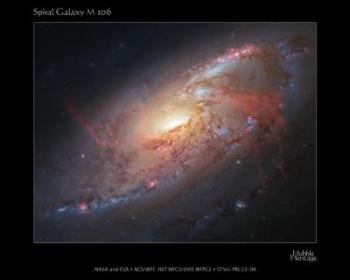Feb 7 2013
Working with astronomical image processors at the Space Telescope Science Institute in Baltimore, Md., renowned astro-photographer Robert Gendler has taken science data from the Hubble Space Telescope (HST) archive and combined it with his own ground-based observations to assemble a photo illustration of the magnificent spiral galaxy M106.
 Working with astronomical image processors at the Space Telescope Science Institute in Baltimore, Md., renowned astro-photographer Robert Gendler has taken science data from the Hubble Space Telescope (HST) archive and combined it with his own ground-based observations to assemble a photo illustration of the magnificent spiral galaxy M106. Credit: NASA, ESA, the Hubble Heritage Team (STScI/AURA), and R. Gendler (for the Hubble Heritage Team) Acknowledgment: J. GaBany
Working with astronomical image processors at the Space Telescope Science Institute in Baltimore, Md., renowned astro-photographer Robert Gendler has taken science data from the Hubble Space Telescope (HST) archive and combined it with his own ground-based observations to assemble a photo illustration of the magnificent spiral galaxy M106. Credit: NASA, ESA, the Hubble Heritage Team (STScI/AURA), and R. Gendler (for the Hubble Heritage Team) Acknowledgment: J. GaBany
Gendler retrieved archival Hubble images of M106 to assemble a mosaic of the center of the galaxy. He then used his own and fellow astro-photographer Jay GaBany's observations of M106 to combine with the Hubble data in areas where there was less coverage, and finally, to fill in the holes and gaps where no Hubble data existed.
The center of the galaxy is composed almost entirely of HST data taken by the Advanced Camera for Surveys, Wide Field Camera 3, and Wide Field Planetary Camera 2 detectors. The outer spiral arms are predominantly HST data colorized with ground-based data taken by Gendler's and GaBany's 12.5-inch and 20-inch telescopes, located at very dark remote sites in New Mexico. The image also reveals the optical component of the "anomalous arms" of M106, seen here as red, glowing hydrogen emission.
Robert Gendler is a physician by profession but has been active in astrophotography for two decades. Robert started taking astro-images from his driveway in suburban Connecticut. He then spent several years imaging remotely from places like New Mexico and Western Australia. More recently, Robert has been spending his time assembling hybrid images from multiple data sources including the Hubble Legacy Archive. Many of these images have been featured on "Astronomy Picture of the Day" and in various books and magazines.
This portrait of M106 contains only the inner structure around the halo and nucleus of this Seyfert II active galaxy. Large amounts of gas from the galaxy are thought to be falling into and fueling a supermassive black hole contained in the nucleus. Also known as NGC 4258, M106 lies 23.5 million light-years away, in the constellation Canes Venatici.